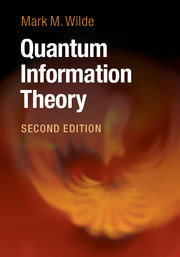Book contents
- Frontmatter
- Contents
- Preface to the Second Edition
- Preface to the First Edition
- How To Use This Book
- Part I Introduction
- 1 Concepts in Quantum Shannon Theory
- 2 Classical Shannon Theory
- Part II The Quantum Theory
- Part III Unit Quantum Protocols
- Part IV Tools of Quantum Shannon Theory
- Part V Noiseless Quantum Shannon Theory
- Part VI Noisy Quantum Shannon Theory
- Appendix A Supplementary Results
- Appendix B Unique Linear Extension of a Quantum Physical Evolution
- References
- Index
1 - Concepts in Quantum Shannon Theory
from Part I - Introduction
Published online by Cambridge University Press: 16 February 2017
- Frontmatter
- Contents
- Preface to the Second Edition
- Preface to the First Edition
- How To Use This Book
- Part I Introduction
- 1 Concepts in Quantum Shannon Theory
- 2 Classical Shannon Theory
- Part II The Quantum Theory
- Part III Unit Quantum Protocols
- Part IV Tools of Quantum Shannon Theory
- Part V Noiseless Quantum Shannon Theory
- Part VI Noisy Quantum Shannon Theory
- Appendix A Supplementary Results
- Appendix B Unique Linear Extension of a Quantum Physical Evolution
- References
- Index
Summary
In these first few chapters, our aim is to establish a firm grounding so that we can address some fundamental questions regarding information transmission over quantum channels. This area of study has become known as “quantum Shannon theory” in the broader quantum information community, in order to distinguish this topic from other areas of study in quantum information science. In this text, we will use the terms “quantum Shannon theory” and “quantum information theory” somewhat interchangeably. We will begin by briefly overviewing several fundamental aspects of the quantum theory. Our study of the quantum theory, in this chapter and future ones, will be at an abstract level, without giving preference to any particular physical system such as a spin-1/2 particle or a photon. This approach will be more beneficial for the purposes of our study, but, here and there, we will make some reference to actual physical systems to ground us in reality.
You may be wondering, what is quantum Shannon theory and why do we name this area of study as such? In short, quantum Shannon theory is the study of the ultimate capability of noisy physical systems, governed by the laws of quantum mechanics, to preserve information and correlations. Quantum information theorists have chosen the name quantum Shannon theory to honor Claude Shannon, who single-handedly founded the field of classical information theory with a groundbreaking paper (Shannon, 1948). In particular, the name refers to the asymptotic theory of quantum information, which is the main topic of study in this book. Information theorists since Shannon have dubbed him the “Einstein of the information age.”1 The name quantum Shannon theory is fit to capture this area of study because we often use quantum versions of Shannon's ideas to prove some of the main theorems in quantum Shannon theory.
We prefer the name “quantum Shannon theory” over such names as “quantum information science” or just “quantum information.” These other names are too broad, encompassing subjects as diverse as quantum computation, quantum algorithms, quantum complexity theory, quantum communication complexity, entanglement theory, quantum key distribution, quantum error correction, and even the experimental implementation of quantum protocols.
- Type
- Chapter
- Information
- Quantum Information Theory , pp. 3 - 25Publisher: Cambridge University PressPrint publication year: 2017

